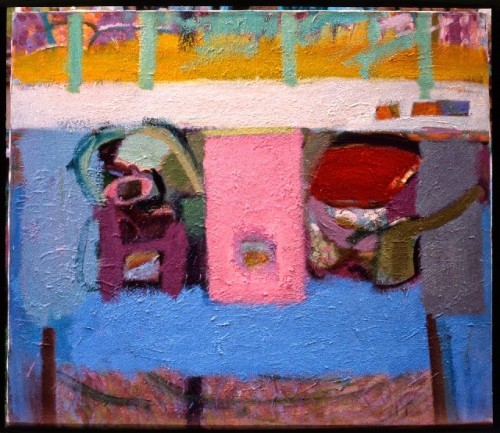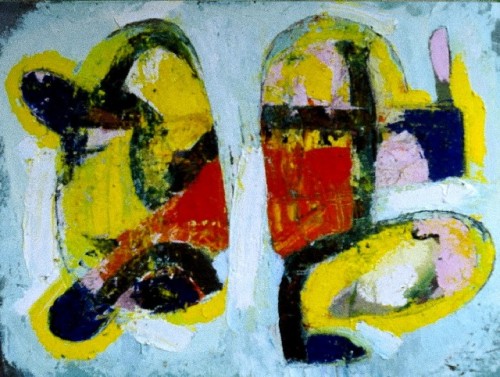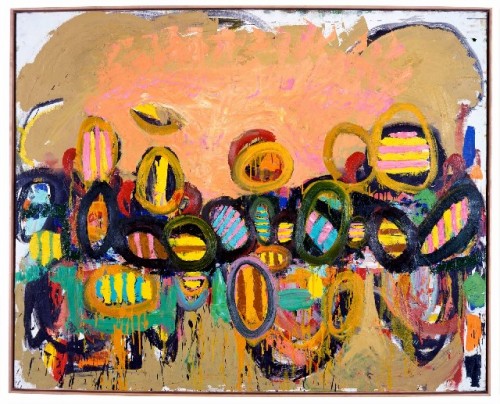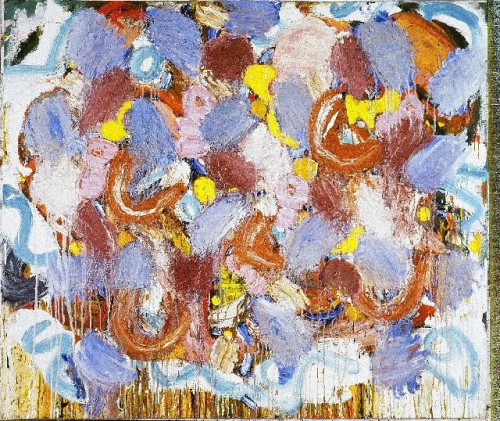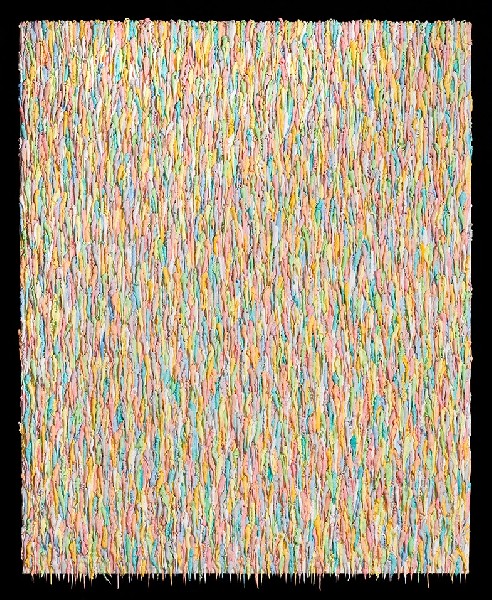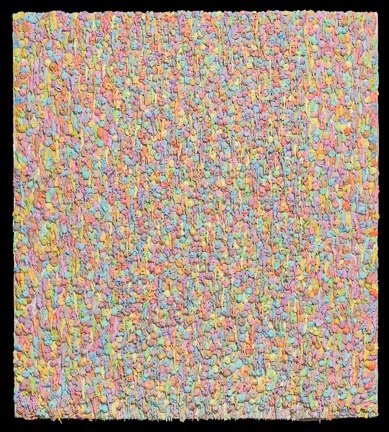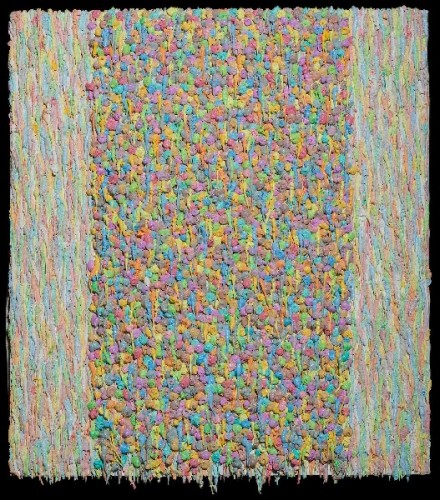Jumping Out of Enframement
Is Everything Mostly Post Moderm
By: Martin Mugar - Mar 30, 2014
My attempt to rethink the notion of provisional painting seems to have had some success judging from the number of favorable responses from people, who had written about this quasi-movement. I say qausi in the sense you are not going to see photos of the Provisionalists, as you did of the Abstract Expressionists photographed in bars together discussing their theories. It is more an educated guess of what appears to be a cultural Zeitgeist. Sort of in the realm of Facebook “likes”. Moreover, I suspect that many of these artists identified as provisional don’t either know each other or reject the label. Has there been a schism within the movement?
What worked for me in order to get a handle on this movement was to take a deductive approach in analyzing it. Rubenstein, hanging out in the Brooklyn art scene, began to see similar gestures and strategies that led him to assume a certain cultural mood was informing all these artists. My approach accepted that there is always a Zeitgeist, which is shaped at any given time by overarching forces, that influence how we act. Whereas he pieced it together empirically, I worked with a notion that is historial, i.e. history gets its impetus from certain seminal ideas that can shape generations. They can work their way into society from the top down and slowly transform it, so that at any given time within an era we can see a stage of that idea’s evolution say from Dada to Punk. The idea will hit a dead-end, lose its shaping power, at which point something totally contradictory will take hold of society to disrupt the status quo. Working with the Vattimo’s ideas of nihilism, I detected a certain winding down of metaphysics in the provisional painters. This social phenomenon that he observed in the artists he met was accurate but he failed to see it as just a particular moment in an ever-evolving push/pull with the nihilist impetus, initiated by Nietzsche, more than a hundred years ago. Nietzsche predicted that Nihilism’s rejection of higher values, to which we aspire so as to transform ourselves as for example in Plato’s notion of the Good or in Superman’s slogan: ”Truth, Justice, and the American way”, would lead to a slow devolution of the individual into a kind of atomized irrelevancy. He had of course a subtle critique of how Christian ideals had dialectically led to this end point but I won’t pursue that here.
Other critics saw this provisionality in the work of Matisse. Every erasure somehow foreshadowed the artists of the early 21st century, whereas in reality they could not have been more different in intent. The aesthetic attitude toward phenomena of Matisse is grounded in a will to control them, based in a positivistic attitude toward the self. Self-consciousness imparts a priori to visual events a certain shape or structure. That structure is not conceived totally intact but is intuited over time. The self-conscious artist is like a scientist empirically collecting data but with the intent of shaping it into a coherent whole. Matisse may have had doubts at any given moment in the execution of a painting but there is a will to the whole that makes him at antipodes with the artists of Provisionalism. Theirs is a “what me worry”, “ approach to art untouched by the “anxiety of influence” that most likely represents a dead-end of metaphysic’s influence on art, for which Vattimo provides the perfect notion of “weak thought”.
I have been accused on my blog by some artists of being a curmudgeon, unwilling to see the good in what is being done in contemporary art ,or by others of not presenting a more positive path for artists to follow. Actually my latest blogs are really not attempts to blame or praise but to dispassionately place (with the occasional snarky comment) what I have seen in the galleries into a larger intellectual and historical context. Without explicitly saying it, I have negatively implied what I think would be a more profitable and rich route to follow in art. I had to accept that the Zeitgeist is one of Nihilism, so that a provisional painter, who is perceived to be deconstructing the polish and technological purity of Koons, is just expressing another aspect of nihilism already embedded in Koons. So, if Nihilism were so pervasive, in order to jump out of its grasp would be to, in a historial sense, establish a new beginning. (I use historial as opposed to historical to distinguish between a sense of history being the play of ideas that we swim in vs. just a list of facts and events that occurred over time). How to do that?
Sometimes, I muse about the centrality of the role of the written word in society and whether its centrality is not being replaced by computer code. Both languages achieve the same purpose, which is to establish a notion of temporal stability or what Heidegger calls “the while”. The reality of the Internet and the computer is one of a constant presence and presencing and words for example, what I am writing now, are establishing the presence of my view on art. Both are also propositions about what is real. But the Internet is more incontrovertible. The network of electricity that runs the computer, the fuel that runs the power plants that make the electricity and the interaction of hardware and software is based on a science that is not a proposition that you can easily deconstruct (pace Derrida). Moreover, as physical fact, it integrates and coordinates the activity of countless people, businesses, countries and political institutions. Heidegger calls this scientific reality “enframement”. Like nihilism it is all around us. It is the real that is rational and in turn its rationality is our reality. But just defining enframement, can’t change the reality of this scientific domain, which insures that we live in a mass culture where everything is wired together. Every attempt to break the bonds of the scientific stranglehold gets coopted by the system. We all have our individual cell phones but the NSA monitors them all. We have our laptops that we can carry around with us and personalize but by virtue of being part of the World Wide Web our activities on that web are monitored.
To get back to my point, writing and for that matter painting, unlike our cyber reality, are the evocations of personal time and are grounded in our body and mind. Painting still privileges the individual and their own notion of time. It is, as well, in an inevitable dialogue with all that painting has ever been, so that intentionally or otherwise the artist is forced to accept the history of painting. Its uniqueness lies in its ability to create time out of its own language, which forces the viewer to linger in front of it. It has physical presence that can only be experienced in a gallery, face to face with the viewer. It can just have a vertical presence that it imposed on the viewer as in a Barnet Newman abstraction. It can stop time as in Richter’s work, or disrupt our routine by turning the world upside down as in Baselitz. Make it repetitive as in Stella’s early work. Explode time into post-apocalyptic dissolution as in Pollock or dogmatically have color push and pull the eye into the canvasses space from the surface and back to it again as in Hoffmann’s work. Kelley by deconstructing the structural elements of the canvas that support the color in a sense dismantles time, (the ultimate manifestation of my Humpty Dumpty effect).
The philosopher Reiner Schurmann in discussing Heidegger’s notion of time makes the point that time is a societal construct purely created by man. His “Broken Hegemonies” is a powerful exposition of the way cultural notions of “what man is” can hold sway for centuries privileging one view of action over others. These paradigms are topological, in that they shape time and space, so that modern art will look very different from a medieval art. The stain glass at Chartres vs. “Broadway Boogie Woogie”. These notions tend to favor group identities and organization over the individual. For Schurmann this gives rise to the tragic condition, when an individual’s actions are out of step with the prevailing and or new cultural paradigms. It is in particular tragic when there are cultural shifts that leave people, who espouse the values of an earlier reality stranded in a brave new world. A story from ancient Greece that captivates Schurmann most, so that it becomes a leitmotiv of “Broken Hegemonies” is that of Antigone, who ignores the laws of the state to bury her brother Polynices. Polynices who has been killed in his attempt to wrest back the throne from his brother Eteocles is considered an enemy of the state and not worthy of proper burial. Antigone inspired by what she sees are more eternal values such as the bonds of family and the ancient will of the Gods ignores the laws of the state. For this she is executed. This notion of conflict between deeply held personal beliefs and those of the status quo becomes paradigmatic of the tragic condition of humanity.
In an earlier book by Schurmann “Heidegger on Being and Acting”, he refers to cultural paradigms as grounded in “arche”, original seminal events from which they draw their energy. The question he raises and which he feels is central to Heidegger’s thought: Can we act anarchically? By this he means without why and without goal, not chaotically. Every epoch is defined by an event that controls how individuals act and how they perceive the whole. Notions of the present and presencing become paramount in the language of Heidegger as well as epochal definitions of how that present is defined. Take for example what he considers to be the last great epoch of mankind that we are still experiencing: the modern era of self-consciousness initiated by the language around Descartes’s ‘cogito ergo sum”. It posits reality on our ability to know it rationally. Schurmann defines the medieval era as one where the individual seeks to be defined by the light of God, which comes from above. In the Modern era man is his own light and shines it on reality. (I suddenly think of our life in cars with their headlights on aimed ahead of us as we willy-nilly try to define our time and space). This notion of the self implies a transcendental attitude toward the self as subject to which everything becomes object or objectified. It gets inflated to the notion of the nation or the people as in Communism. Heidegger, who had already in his early work tried to ground mankind in the world into which he is thrown, becomes more conscious of the definitions of the overarching society, which are extensions of the individual definitions to the world when he himself gets caught up in National Socialism. All his subsequent writing is aimed at extricating the fallacies of his thought that lead to that association.
A word that comes up in discussions of Heidegger’s very Nietzschean and aphoristic “Contributions to Philosophy” is poiesis. It is meant to indicate the growth of something in time out of a unique origin. It is held up in distinction to the propositional nature of modern western thought. Propositional thinking pins things down, stops them like a snapshot and or entangles them in mathematical formula. Poiesis lets things be and understands them in their reality in the world as a nexus of events. Heidegger is totally cognizant of the reality of the modern world and comes up with several notions that allow us to get a handle on it: one is Machination the other giganticism. Machination came out of his reading of Ernst Junger’s ”The Worker” which studied the total mobilization of a nation during the National Socialist era but it could be as easily applied to Fordism in the United States. Giganticism tries to grasp the economics of enormous scale that define the US and Russia of the Soviet era. For Heidegger this is the outcome of the metaphysics of self-consciousness as it evolves into economics of quantity over quality. How does one live on this “monstrous site” ?(Schurmann’s words)
Schurmann describes three modern strategies that avoid the tragic view of life. “If there is a task and a possibility for thinking today, it can only be that of letting normative consciousness collapse-not by putting a stop to philosophy so as to pass on, whether to the science (the Anglo-Saxon temptation), or to literature (the French temptation) but by learning not to have wholehearted faith in semantic maximization.” The third is the phenomenology of Husserl, whom he dismisses as a bureaucrat. Husserl tends to cover over the abyss with the possibility of clear unambiguous ideas and shapes that have a certain incontrovertible nature to them. Husserl had been instrumental in establishing the notion of intentionality, that all ideas are about something and therefore place us in a lived world. Intentionality had a big impact on his student Heidegger. However, Husserl remained unwilling to put the self completely in the world as Heidegger did and held on to the self-conscious apprehension of the world in clear and distinct ideas. These were referred to as “eidetic” reductions, or observable and concrete shapes and form of what is. This had a big influence on modern art in Positivism’s clear shapes and clear issues that are purely intended for societal maximization of technological. Malevich, Mondrian, Stella, Sol Lewitt, Donald Judd, Wade Guyton, minimalist architecture. Only Rothko knows he is papering over the void. Warhol’s uploading of the commercial to the level of art. The literary turn that Schurmann refers to is Deconstruction: taking apart the metaphysical prejudices of gender, colonialism and any power structures embedded in our Western literature: This includes all installation work tending toward a critique of how reality is shaped, most typically by commerce. The ideas of deconstruction predate the 80’s when it became popular in the work of Duchamp and Rauschenberg. Warhol could be considered a deconstructionist, although I see him along with Lichtenstein, Rosenquist and Koons as just validators not critics of the primacy of the commercial in modern society. In architecture you could include any architect who uses modern material to create buildings like Gehry that look like they are falling apart.
When I taught Western Civilization at UNC-Greensboro, my first lecture started with slides of sculptures of men on horseback dating from the Assyrians to modern times. These for me embodied the reality that all civilizations are built on the backs of a suppressed people and that the first examples of art showing sympathy for the oppressed were Delacroix’s Massacre at Chios and Goya’s Black Paintings. Schurmann says as much when he makes the point that all public realms are built out of a tragic event where family bonds are sacrificed as in Agamemnon’s sacrifice of Iphigenia or Creon’s execution of Antigone.
I don’t think that art likes to dwell in this spot and if it does it most often is not for long. Schurmann borrows the pair of concepts, natality and mortality from Hannah Arendt, with whom he taught at the New School in New York, to show how each new generation (natality) favors maximization of ideas that give new shape to society: whether it be socialism or communism or technology. He uses also the word thetic, which I take to be equivalent to ideological to describe how ideas become totalizing during the reign of any given Hegemony. Each generation takes the world for their own bowl of cherries. But as they age their singularity (Mortality) becomes more important or the thetic realm can be so harsh as it was for Shostakovich in the Soviet Union that his work is from the beginning all about the struggle of the individual against the ideological realm. Most of his colleagues were happy to sing the praises of the Soviet People and the nomenclature, although they acknowledged the superiority of Shostakovich’s genius, had little tolerance for the schizoid back and forth between harmony and dissonance. He avoided prison unlike the Armenian filmmaker Parajanov , who did ten years for his implicitly anti -communist work “Shadows of our Forgotten Ancestors”. The evolution of say Michelangelo from the metaphysical glories of the Last Judgment to the poignant unfinished pietas captures that transition perfectly. Hired by the Church at the height of its power to describe the interpenetration of heaven and earth to singularizing his own struggle to transcend his mortality is full of pathos.
I doubt that this notion of the tragic will ever become central to any modern aesthetic. It is not how the world works. The Modern world needs common currency to perform its day-to-day tasks. It has to be inert and function as multiples. I thought of how perfect Wade Guyton inkjet images function as inert units of printed exchange. At all costs the objects that the Wall Street hedge funds buy have to be drained of human feeling. And if there is any horror these days at the positivist and commercial bias of our artistic language it is only snarky and dandified.
How does one paint in the context of society enframed by the technological and the commercial? If Schurmann imagines that “normative consciousness” should collapse what does he mean by that? He refers elsewhere to a distinction between societal time and primordial time. Is this the leap we have to take to experience something alive and new? Heidegger applies all sorts of thought experiences to contextualize the societal notion of time. Sometimes he sets it off against the darkness of the earth and talks of how the artist uses the earth in his or her painting, a literal grounding of the abyss. At others he imagines society (the world) interfaced with the abyss. Another thought experiment is his notion of letting things be. Not entrapping the world in a framework of science. Letting the things “thing” or the world “world”.
I have always painted out of a reverence for the many visual languages I have learned from my teachers and from my study of the multifarious artistic cultures both east and west. I would like to think I have followed Heidegger’s notion of thinking as thanking. I observed in the evolution of Western Art over the 20th century: a move toward understanding optically how we perceive the real. I saw each stage as an expansion of the power of the vocabulary afforded the artist so that, oblivious to the current art scene, I would try to absorb for example the colors of the Fauves, when the art world was enthralled by Minimalism, in so far as I saw it as step toward understanding more deeply what made Minimalism possible. To reduce my language to simple and pure colors as building blocks was for me a singular achievement. At any given point in this evolution I would hit on something that pushed back or glimmered out of the dust of my search, similar to a prospector hitting pay dirt. By the mid-Nineties I had pretty much worked my way up to the push and pull language of Hoffmann using pure flat color shapes. The flip-flop of figure ground ambiguity intrigued me. It slowed time down in the painting as it held the attention of the patient viewer, who could wait for the image to rearrange itself. Around the mid to late Nineties, something took hold of my work, whereas up until that point I was reducing the images to simple flatness and for the most part this was an act of will. It embodied conflict. What else is the push-pull about? A sense of multiplicity of being part of a world, that was bigger than my own personal struggle to make sense out of the space on my canvas, took hold of my work rather spontaneously in the late Nineties. This acceptance of the multiple as a basis for organizing a painting lead me through an evolution, where all conflict seemed to create a sort of delirium that lead to its disappearance. The goal of the painting was to listen to it as a whole.
Since 2000 I have pursued an art that abandons the languages that I had so assiduously acquired over many years. I began with a flat surface of dots and expanded the affects of that vocabulary incrementally over time. Adding wax to bring the paint off the surface, dripping the paint off the bottom of the canvas, adding more and more color combinations. Using a frosting applicator to bring back the volume that I had long abandoned in my move from figuration to abstraction. Reviving the figure/ground ambiguity by playing variations in the center off of the sides. Most recently, I have abandoned that sort of centrality to an all-over approach, where no one area has primacy over any other and foregrounding the freedom of each mark. I am hesitant to try to apply any of Schurmann or Heidegger’s concepts to describe my work; for fear that one might think that my paintings are conscious attempts to apply their theories. If there is an influence it is indirect. Poiesis, the evolution of the painting over time is probably relevant. Primordial time embodied in the work itself which is unforced. The embodiment of the “while”, not time engaging an imposition but of letting be.
Reposted courtesy of Martin Mugar from Painting.

